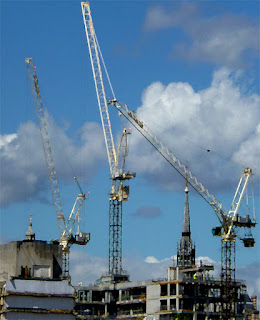On a scanned copy of my etching I used some grey Pitt pens to colour in areas with 2 different tones. Then using etching stop-out varnish ( as sticky bituminous mixture) on my plate I painted the areas that would be reserved as white, a counter-intuitive procedure!
Then donning mask and gloves, a thin layer of resin was applied to the plate using aquatint box ( basically a dust cloud of resin! ) I should really have used the stop- out afterwards as it's inflammable and part of the process involves heating the plate from underneath to melt the resin.
Then the plate was put in week acid for 15 seconds, more stop-out varnish applied to light toned areas just etched and for the darker tone the plate was put in the weak acid for a further 45 seconds.
Then the stop-out varnish was removed with paraffin ( resulting in this rather nice effect of the gold of the resin) ) and the resin removed with methylated spirits.
Then the exciting bit! There was just time to ink up with Prussian blue - I'm getting better at judging how much ink to take off , and put it through the press.
I'm not sure I'll want to do etching and aquatint in the future, as it requires access to facilities and there's a lot of processes involved. But I've gained a whole new respect and insight into what goes into an etching and looked at the prints in the RA summer Exhibition with a new perspective on my visit on Wednesday (more in another post)
The 'Develop your drawing ' class this week was off-site around Waterloo Bridge collecting sketches and information for a 2 week project on the theme of Journey. My sketches really were sketchy but I had a lovely time scribbling .Below are some of the photos I took as a reminder, I'll probably do a bit of playing in Photoshop to develop some ideas for next week.










1 comment:
I do like those prints, lots of inspiration for textiles.
Post a Comment